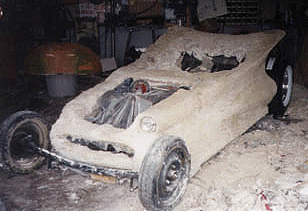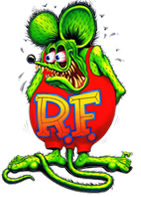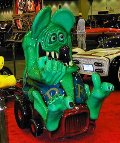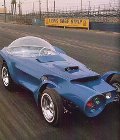
Read below to learn more about how Ed Roth cars were made:
Ed’s famous “plaster and fiberglass” method.
Ed created his show cars like no one else. Ed Roth Cars were not just an off-the-assembly-line models modified with body work, all were unique creations.
Seeing a picture of Henry Ford using a sledge hammer on a fiberglass trunk lid was enough to give Ed the fantastic idea to begin building fiberglass Ed Roth Cars. He liked the idea that fiberglass was very cheap and that it didn’t require a lot of training to use, as Ed put it, “It could also be done by people with little or no talent and I had both.”
In 1957 Ed Roth Cars started to be made using fiberglass. Ed experiment using fiberglass with his first fiberglass creation “Outlaw”. Finding help with the Ed Roth Cars using this new process was hard. At first Ed was going to use wood to build the body and lay the fiberglass on. Things started getting too complicated trying to use wood, “Wood and me don’t jive,” Ed said. Looking for something other than wood to use, Ed went to a local lumber yard and picked up some casting plaster. Casting plaster was better than wood and very cheap.
Making adjustments on the plaster body was easy, Ed used a saw if he needed to take something off. To add something he would just poke a coat hanger into the body for support and start building it up with plaster. After the plaster body started to take shape, Ed would then start smoothing it down using sand paper. All the sanding created a deep layer of plaster dust on everything in the garage.
Finding it harder to keep the garage clean Ed decided to clean only the floor after finishing each of his Ed Roth Cars. Dirty Doug (Doug Kinney) helped Ed create his show cars, they would find all sorts of screwdrivers and as Ed put it “neat junk” in the sweepings, mostly screwdrivers. Along with the plaster dust there was a lot of fiberglass dust too. Ed said, “fiberglass dust is worse’n itching powder, but Me and Doug wuz pretty use to it.”

Plaster Body
Not until the plaster body of the Ed Roth Cars were shaped and smoothed as Ed wanted it did the fiberglass get applied. Ed said, “it’s one of the gooiest messes you would ever want to see.” Pants were ruined and thrown away by the end of each day and shoes would last up to four days before he would spray a coat of black paint on them. The fiberglass process of the Ed Roth Cars combines the use of a special epoxy resin and fiberglass fabric that once applied, dry into a very strong material.
After the fiberglass body of the Ed Roth Cars had time to harden, the plaster underneath was knocked out using rubber hammers. It has been said that in some of the tight areas of certain Ed Roth Cars, the plaster still remains. More sanding took place to get the body ready for painting. Ed painted most of his cars before ’59. Beginning with the Beatnik Bandit, Ed started using Larry Watson to paint his Ed Roth Cars. Ed said, “Paintin’ cars wasn’t my favorite trick” and he felt that if one didn’t stay on top of the latest techniques the results could be disastrous.
With the body out to be painted, the Ed Roth cars would have the chassis, engine, drivetrain and wiring finished up. Ed liked gathering extra parts for his Ed Roth Cars in junk yards and through trades. Usually everything would get chromed plated. He would assemble all the pieces after everything was back at his shop, saving the interior for next to last.
Using his plaster and fiberglass method Ed would repeat this process though out his show car career, making not only his Ed Roth Cars unique creations, but the process they were created unique also.











